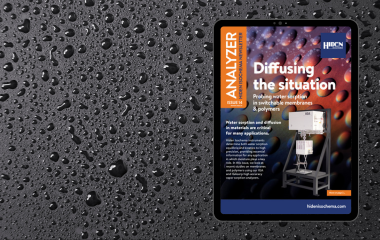New Year’s (Sorption) Resolutions
A 2007 study by the British psychologist Professor Richard Wiseman, involving 3000 people who had set themselves New Year’s resolutions, found that only 12% of them had actually achieved their goals by the end of the year.
Here at Hiden Isochema we’re hoping to be more successful than that and are pinning our hopes on a potent mix of willpower, grit, determination and the fact that we haven’t made any in the first place.
However, not wishing to miss the opportunity for a good pun, we thought we’d start the New Year with a few comments on the resolution of gas and vapor sorption instrumentation, which is the type of resolution that means the most to us, as sorption specialists.
In the context of sorption measurement, the resolution can be defined as the minimum detectable quantity of gas or vapor is taken up (or released) by a material. It’s a difficult parameter to quantify precisely because it is dependent on a number of factors.
In the case of gravimetric instrumentation, such as our IGA and IGAsorp series, the resolution is essentially defined by the resolution of the microbalance, which is +/- 0.1 μg, although in practice the balance stability is just as important, if not more so. Our gravimetric instruments have a long-term balance stability (over a week or more) of +/- 1 μg. The conversion of this into a molar quantity obviously depends on the species under consideration. The molar resolution will be lowest for hydrogen, but considerably greater for larger organics, for example.
In the manometric case, such as our IMI series, the resolution is dependent on the volume of the system and the resolution of the pressure measurement. The combination of these two factors allows the calculation of a minimum detectable sorbed quantity. The IMI series combines high-pressure measurement accuracy with a minimized internal dead volume for this reason and can detect submicromole quantities of gas uptake (or release). However, the calculated resolution, in this case, is defined directly as a molar quantity because this technique uses the real gas law, PV = nZRT, to measure sorption. Therefore, in order to compare the resolution of the gravimetric case, the molar quantity must be converted to a mass using the molecular weight of the species under consideration. In this case, the highest (equivalent) weight resolution is found for hydrogen and the lowest for larger molecules.
However, even when considering hydrogen, the manometric technique, despite its advantages, struggles to compete with gravimetry with regard to weight resolution. This is one of the main reasons why gravimetric sorption measurement is intrinsically more accurate than its manometric (volumetric or Sieverts’-type) counterpart.
In addition, there are a number of other factors that can affect the real resolution of a sorption measurement, including the sample size, its uptake behaviour and other instruments performance parameters, such as the thermal stability and control of the both the apparatus and the sample temperature.
We would welcome the opportunity to discuss these with you in more detail; so if you’d like to find out more, with regard to your specific application, please contact us now.
Otherwise, we’d be more than happy to help you with strategies for keeping your 2013 New Year’s resolutions, although you might be better off speaking to Professor Wiseman about that.


